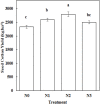Nitrogen Fertilization Increases Root Growth and Coordinates the Root-Shoot Relationship in Cotton
- PMID: 32655605
- PMCID: PMC7324761
- DOI: 10.3389/fpls.2020.00880
Nitrogen Fertilization Increases Root Growth and Coordinates the Root-Shoot Relationship in Cotton
Abstract
The root system plays an important role in the growth and development of cotton, and root growth is closely related to shoot growth, both of which are affected by N availability in the soil. However, it is unknown how N affects root growth and the root-shoot relationship under various N rates in the Yellow River Basin, China. Thus, the aim of this study was to assess the impacts of the application rate of N on root growth and the root-shoot relationship, to provide insight into the N regulation of root and shoot growth and N efficiency from the perspective of the root system. A field experiment conducted in 2014 and 2015 was used to determine the effects of N rates (0, 120, 240, and 480 kg ha-1) on root morphology, root distribution, the root-shoot relationship, and cotton yield. A moderate N fertilization rate (240 kg ha-1) increased root length, root surface area, and root biomass in most soil layers and significantly increased total root growth and total root biomass by more than 36.06% compared to the 0 kg ha-1 treatment. In addition, roots in the surface soil layers were more strongly affected by N fertilization than roots distributed in the deeper soil layers. Total root length, total root surface area, and root biomass in the 0-15 cm layer were significantly correlated with shoot biomass and boll biomass. In the 60-75 cm layer, total root length, total root surface area, and root length were significantly positively correlated with seed cotton yield. The application of a moderate level of N markedly increased total shoot biomass, boll biomass, and seed cotton yield. Our results show that increased shoot and boll biomasses were correlated with a significant increase in the root system especially the shallow roots in the moderate N treatment (240 kg ha-1), leading to an increase in cotton seed yield.
Keywords: N fertilization; cotton; root distribution; root morphology; shoot biomass.
Copyright © 2020 Chen, Liu, Wang, Zhang, Sun, Song, Bai, Lu and Li.
Figures









References
-
- Ali M. A., Mushtaq A., Mueenud D. K. Y., Yamin M. (2007). Effect of nitrogen and plant population levels on seed cotton yield of newly introduced cotton variety CIM-497. J. Agric. Res. 45 289–298.
-
- Alitabar R. A., Salimbeck R., Alishah O., Seyed A. A. (2012). Interactive effects of nitrogen and row spacing on growth and yield of cotton varieties. Int. J. Biol. Sci. 4 120–125.
-
- Amato M., Ritchie J. T. (2002). Spatial distribution of roots and water uptake of maize (Zea mays L.) as affected by soil structure. Crop Sci. 42 773–780. 10.2135/cropsci2002.7730 - DOI
-
- Bange M. P., Milroy S. P., Thongbai P. (2004). Growth and yield of cotton in response to water logging. Field Crops Res. 88 129–142.
LinkOut - more resources
Full Text Sources
Other Literature Sources
Research Materials

